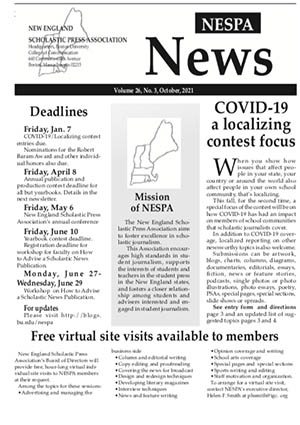Wayland editors describe their news service
by Samantha Cabral
In the world of publications, some may think that hosting an online news source is the job of CNN or FOX News.
However, at Wayland High School, www.waylandstudentpress.com is impressing its audience with its online service.
“To create this site, we went through a lot of start-up phases,” co-editor in chief Melanie Wang said in a presentation at the New England Scholastic Press Association’s 62nd annual conference Friday, April 30, at Boston University.
“It requires you to change the way you think because the system has to change, be able to adapt to new technology and meet the needs of the audience.”
Having “the power of the pixel” is a great benefit, according to David Ryan, co-editor in chief and webmaster.
“There are no limits to the length of a story or to the amount of content that we publish,” he said.
Both students said the Internet is a more useful tool than printing a daily newspaper.
“Using the Internet opens new doors to reports on breaking news,” Ryan said. “If something happens, a report can be up in 30 minutes or less. And, if we need to, updates can be made on reports that are already up. This changes the way you do reporting.”
Also, Wang said, other possibilities come with online news publication.
“You can have videos, slide shows, sound slides, graphs, charts, links and huge amounts of sources,” Wang said.
“You can reach around the world even if the focus is on your own town.”
For the Wayland Student Press, reaching around the world is not an exaggeration.
“Google Analytics is great to use for feedback,” Ryan said. “We can see how viewers found the site and where they are seeing it from so we can try to make it more accessible for them.
“So far, we have reached seven continents. One out of 10 visitors to our site is using a mobile device.
“They say the mobile web will grow insane amounts in the next few years. The web is constantly changing, and it is important to update and adapt. The Internet is unpaved territory.”
Using this territory is an ideal way to reach the targeted audience: students, Ryan said.
“The Internet is a teen-ager’s natural habitat,” Ryan said. “By putting a publication online it becomes more open to students. Change comes every month, every day, every year. Standards need to be followed. We still need to keep in mind ethics, grammar, punctuation and making sure that all content is accurate.”
Having an online news publication does not mean the editors have less work to do than on a paper that comes out in print.
“How to divide the content is important in terms of design,” Wang said. “We have to think about how often we should publish, and what is the most important. The best thing to do is look at other sites and think about the things you like and don’t like.
“Just remember to stay true to yourself. It’s still a high school publication.”
Aside from simply posting stories, the editors have also made their site more informal for visitors.
“Social networking sites can be used to get user feedback and have a way to make the site more casual,” Wang said.
“We created a Facebook fan page back in October, and now we have more than 500 fans. We have a comment policy and all comments are read by the editors.”
Another way to view the website is through the mobile Internet. More people having cell phones that can access the Internet means more people are reading their news from the mobile version of the site, Ryan said.
“Phones are becoming the place where most people are getting their news,” he said.
“Mobile devices are going to be key for the next five to six years.”
When it comes to mastering Internet publication, it is important to remember that it is constantly changing, and so is technology, Ryan said.
“Things can change at the drop of a dime, but the context can be kept fresh easily,” Ryan said. “People who want to get into this have to lose the I’m-afraid-of-a-computer attitude.”
Samantha Cabral is an editor of The Villager at Westport High School in Westport, Mass.

